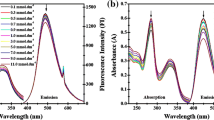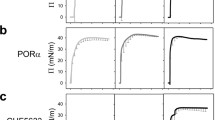Abstract
Purpose. The association of hydrophobic, cationic drugs with lung surfactant was determined to assess the pharmacokinetic implications on drug disposition and retention in the lung.
Methods. The distribution coefficients, K, were determined at 25 and 37° in normal saline solution buffered at pH 7.4 for a series of structurally related, cationic drugs. Drugs were dispersed into lung surfactant, equilibrated, and then centrifuged to separate the aqueous phase from the surfactant pellet. Drug concentrations in the supernatant and pellet were determined following dilution using spectrophotometric assays. In addition, the apparent acid dissociation constant of quinacrine in the presence and absence of surfactant was determined by measuring the pH-dependent absorption spectra. The effect of stereochemistry on the distribution of drugs into surfactant was examined with (R)- and (S)-propranolol.
Results. The mole fraction distribution coefficients for amitriptyline, promethazine, promazine, ethopropazine, imipramine, R-propranolol, and S-propranolol at 25°C were 6,560 ± 500, 28,400 ± 1,500, 12,100 ± 840, 5,480 ± 330, 4,490 ± 250, 8,680 ± 260, 8,190 ± 530, respectively. At 37°C, the distribution coefficients were generally smaller indicating a significant exothermic heat of transfer for these solutes from aqueous solution to the lung surfactant. The pKa of quinacrine was 7.43 ± 0.04 in aqueous solution and was shifted to 7.62 ± 0.06 in the presence of lung surfactant. From this shift, the double layer potential for quinacrine-lung surfactant was estimated to be −0.012 V assuming a dielectric constant equivalent to that of water.
Conclusions. Cationic drugs have very favorable distributions from an aqueous solution to the lipid phase of lung surfactant. The transfer process generally has both a large entropic and enthalpic contribution. The latter thermodynamic aspect may be related to the charge interaction between the solute and the negatively charged surfactant. Finally, no significant effect of stereochemistry was evident with the distribution of (R)- and (S)-propranolol.
Similar content being viewed by others
References
R. H. Notter. Lung Surfactants. Basic Science and Clinical Applications, Marcel Dekker, Inc. New York, 2000.
S. M. McAllister, H. O. Alpar, Z. Teitelbaum, and D. B. Bennett. Do interactions with phospholipids contribute to the prolonged retention of polypepetides within the lung? Adv. Drug. Del. Rev. 19:89-110 (1996).
T. S. Wiedmann, R. Bhatia, and L. W. Wattenberg. Drug solubilization in lung surfactant. J. Control. Rel. 65:43-47 (2000).
S. Pham and T. S. Wiedmann. Dissolution of aerosol particles of budesonide in Survanta, a model lung surfactant. J. Pharm. Sci. 90:98-104 (2001).
R. N. Upton and D. J. Doolette. Kinetic aspects of drug disposition in the lungs. Clin. Exp. Pharmacol. Physiol. 26:381-391 (1999).
M. S. Rose, E. A. Lock, L. L. Smith, and I. Wyatt. Paraquat accumulation: tissue and species specificity. Biochem. Pharmacol. 25:419-423 (1976).
Z. Wu, P. Upadhyaya, S. G. Carmella, S. S. Hecht, and C. L. Zimmerman. Disposition of 4-(methylnitrosamino)-1-(3-pyridyl)-1-butanone (NNK) and 4-(methylnitrosamino)-1-(3-pyridyl)-1-butanol (NNAL) in bile duct-cannulated rats: Stereroselective metabolism and tissue distribution. Carcinogenesis 23:171-179 (2002).
P. S. Chen Jr., T. Y. Toribara, and H. Warner. Phosphorus determiniation. Anal. Chem. 28:1756-1758 (1956).
K. E. Reilly, A. J. Mautone, and R. Mendelsohn. Fourier-transform infrared spectroscopy studies of lipid/protein interaction in pulmonary surfactant. Biochemistry 28:7368-7373 (1989).
K. A. Connors. In A textbook of pharmaceutical analysis, 2nd ed., John Wiley & Sons: New York, 1975, pp. 131.
A. Albert and E. P. Serjeant. The determination of ionization constants. Chapman and Hall Ltd., New Fetter Lane, London, 1971, pp. 44-60.
M. S. Fernandez and P. Fromherz. Lipoid pH indicators as probes of electrical potential and polarity in micelles. J. Phys. Chem. 81:1755-1761 (1977).
C. J. Drummond, F. Grieser, and T. W. Healy. Acid-base equilibria in aqueous micellar solutions. Faraday Disc. Chem. Soc. 81:95-106 (1986).
J. T. Rubino and W. W. Berryhill. Effects of solvent polarity on the acid dissociation constants of benzoic acids. Pharm. Res. 75:182-186 (1986).
A. Bratts and B. I. Axelsson. Inhaled glucocorticosteroids in asthma. In R. P. Schleima, W. W. Busse, and P. M. O'Byrne (eds), >Mechanisms and clinical actions. Lung Biology in Health and Disease 97, Marcel Dekker, New York, 1995, 351-379.
G. Hochhaus, H. Mollmann, H. Derendorf, and R. J. Gonzalez-Roth. Pharmacokinetic/pharmacodynamic aspects of aerosol therapy using glucocorticoids as a model. J. Clin. Pharm. 37:881-892 (1997).
S. Suarez, R. J. Gonzalez-Rothi, H. Schreier, and G. Hochhaus. Effect of dose release rate on pulmonary targeting of liposomal triamcinolone acetonide phosphate. Pharm. Res. 15:461-465 (1998).
R. J. Gonzalez-Rothi, S. Suarez, G. Hochhaus, H. Schreier, A. Lukyanov, H. Derendorf, and T. D. Costa. Pulmonary targeting of liposomal triamcinolone acetonide phosphate. Pharm. Res. 13:1699-1703 (1999).
Author information
Authors and Affiliations
Corresponding author
Rights and permissions
About this article
Cite this article
Liao, X., Wiedmann, T.S. Solubilization of Cationic Drugs in Lung Surfactant. Pharm Res 20, 1858–1863 (2003). https://doi.org/10.1023/B:PHAM.0000003386.33834.cd
Issue Date:
DOI: https://doi.org/10.1023/B:PHAM.0000003386.33834.cd




